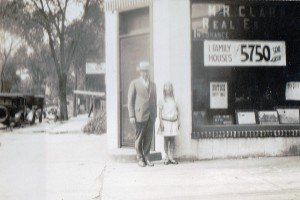How do you choose photos for a family history? Someone recently asked me that excellent question. She happened to have dozens, if not hundreds, of photos and didn’t know how to start. I had never really come up with guidelines for selecting photos, but as I answered the question, I realized that I do have some rough rules of thumb:
- Digitize everything. For publication, you will need to have all your images in digital format; why not scan all you have? That will give you an easy way to view them in one format – and will put you along a path to creating a digital archive of your photo collection. Make sure to scan at a minimum of 300 dpi/ppi. Here’s a good guide.[1]
- Create electronic folders for each ancestor or family group. If you have already started writing a family history and have a file structure for your writing, create a parallel file structure for your images and sort them accordingly. Creating a separate art log can also help you organize your images and thoughts.
- Illustrate as many people as you can. Try to have an illustration for most if not all key people in your ancestry. If your family history goes back a dozen or more generations, of course, that will be difficult. In that case, see item 10 in this list.
- Aim for balance throughout the book. Undoubtedly you will have many photos of one person and few of others. You needn’t include every photo of each person. Your goal is some kind of balance: say, two to four photos per chapter. But don’t be slavish about these guidelines. One person’s life might warrant more photos than another’s. Your log will help you keep track.
- Select photos from throughout a person’s life. Given the choice, for any significant person in your family history, you might opt to select a photo from babyhood or childhood, one from young adulthood (perhaps a wedding photo), and one from later in life.
- Select photos showing family groups. Photos of family groups have the advantage of showing many people at once – and also to show your relatives interacting with each other, particularly if the photos are candid or informal.
- Include informal photos. As implied in step 6, informal photos are more likely than studio portraits to bring your ancestor to life. They also show everyday clothing and everyday settings.
- Include images of homes. Not all your photos need to show people; don’t forget family homes or other places of significance. Bonus points if you have a photo of people in front of a home or business. I particularly love the photo (above) of my young mother-in-law with her father in front of her father’s real estate office, because it brings them – and also the place and the era – to life.
- Assess the overall image quality. Once you’ve done your preliminary selection, you might still have dozens of photos in front of you. Then I’d choose the best-quality image – with “quality” relating to the physical quality of the image, such as its sharpness, contrast, or composition, or to its character: that is, whether it shows personality.
- Supplement with photos or images from other sources as necessary. Sometimes you just have no photos of a person. In that case, look for something to illustrate his or her life: a photo of the church or school he or she attended; an image or map of a town where he or she lived; the person’s signature on a document; a birth, marriage, death, or other record – or a detail from a census. Here’s a list of some potential online sources.
What if you have only one image of, say, your great-grandmother, and it’s a poor one, blurry or damaged in some way? Use it anyway! Even a poor-quality image gives us a sense of what the person looked like—and that’s more important than worrying about a tear or a blemish. And don’t overdo it on photo editing. Re-watching Ken Burns’ The Civil War series recently, I noticed that many of the images have spots and other blemishes. Somehow, those flaws give them character and lend a sense that, like their subjects, these photos have been through a lot.
Have you been through this process recently? What hints would you pass along?
Note
Share this:
About Penny Stratton
A veteran of the book publishing industry, Penny Stratton retired as NEHGS Publishing Director in June 2016; she continues to consult with the Society on publications projects. Among the more than 65 titles she managed at NEHGS are The Great Migration Directory, Elements of Genealogical Analysis, Genealogist’s Handbook for New England Research, and the award-winning Descendants of Judge John Lowell of Newburyport, Massachusetts. She has written for American Ancestors magazine and is a regular poster on Vita Brevis. With Henry B. Hoff, Penny is coauthor of Guide to Genealogical Writing: How to Write and Publish Your Family History; she is also the author of several Portable Genealogists on writing and publishing topics.View all posts by Penny Stratton →
